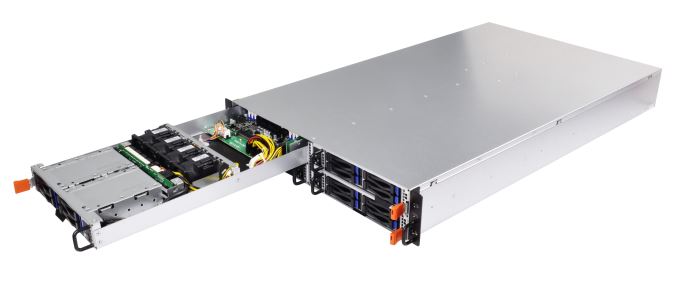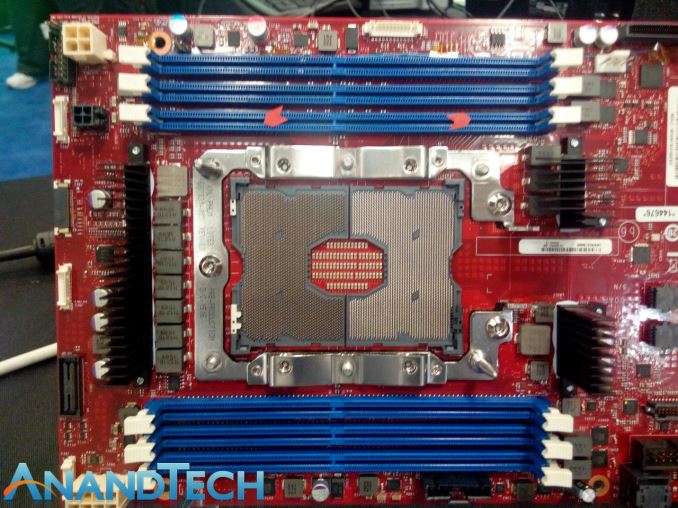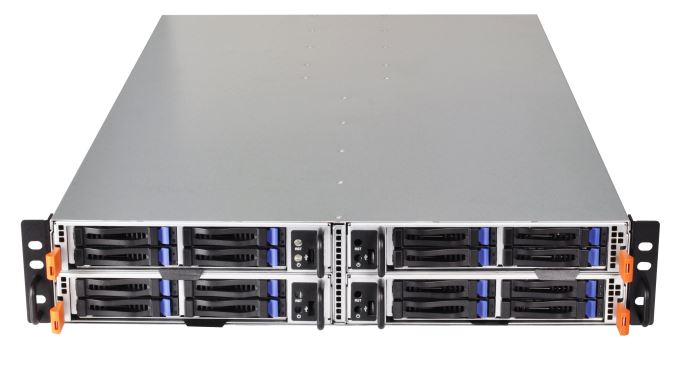ASRock Rack Launches the 2U4N-F/X200: Four 72-core Knights Landing Xeon Phi CPUs in 2U
by Ian Cutress on August 15, 2016 9:00 AM EST
This week is Intel’s Developer Forum in San Francisco, the annual event where Intel and Intel’s partners show their latest products and discuss a number of core topics to Intel’s business. Last year the focus was on the new Skylake microarchitecture, and this year we have down on our list a number of 3D XPoint and Xeon Phi discussions and announcements. One of the first to contact us with their IDF news was ASRock Rack, the server arm of ASRock, about their high-density Xeon Phi solution.

Overview of Xeon Phi X200, Knights Landing
The Xeon Phi many-core platform is transitioning from an add-in card to stand-alone processor, with the latest Knights Landing generation offering up to 72 high performance cores (now a couple of generations away from a pure Atom core) with combined high-bandwidth MCDRAM and the potential for Intel Omnipath support directly on the package. We covered the discussion and launch of Knights Landing last year at Supercomputing15, and saw some preview customer systems at Computex a couple of months ago, however the mix of ISC16 and IDF16 has most of the enterprise consumer-focused system releases surrounding Knights Landing.
For a segment of Xeon Phi customers, density is important. Pack ‘em, rack ‘em and stack ‘em is the end goal, and the 2U4N-F/X200 aims to do just that. The 2U server uses half-width modules to fit in four separate systems in the chassis, each with an X200 Xeon Phi CPU, six DIMM slots with support for DDR4 2400/2133 RDIMM/LRDIMM, four 2.5-inch storage slots (either 4xSATA/SAS or 2xNVMe+2xSATA/SAS), two PCIe 3. X2 slots, one M.2 slot, a combination 1600W 80 PLUS Platinum redundant (1+1) power supply for the four nodes, two GbE Intel i350 network ports and integrated IPMI 2.0 (via AST2400) with KVM and a dedicated LAN port.

P1 Socket for Xeon Phi, seen at Supercomputing15
Xeon Phi uses Intel’s P1 socket, which we saw back at Supercomputing15 and has been characterised in recent media as the LGA-3647 socket. At this point in time, Intel has only confirmed this socket for Xeon Phi use, and other use cases are not yet verified. ASRock Rack states that their platform on show at IDF16 this week will support all the main Xeon Phi X200 CPUs, and they have support in the works for Omni-path associated SKUs. Professional users interested in ASRock’s high-density platform will have to get in contact with their regional branch for more information and pricing.
Source: ASRock



















33 Comments
View All Comments
asdacap - Monday, August 15, 2016 - link
That is a huge socket.yannigr2 - Monday, August 15, 2016 - link
So many pins to bend :pHollyDOL - Monday, August 15, 2016 - link
That wouldn't have much relevance, almost all of those will be either machine or highly skilled and insured professional IT personnel installed... And when so I doubt it would be installed more than once.ddriver - Tuesday, August 16, 2016 - link
So they should directly solder the chips onto the mobo then...andychow - Thursday, August 18, 2016 - link
I'm not sure if you're joking or not, but these are pin-less. The motherboard has spring loaded "pins", that are really curved strips, and the processor has little semi-spherical indentations. It's reverse what we had 10 years ago, and pins no longer get bent. Except with AMD...mdw9604 - Monday, August 15, 2016 - link
"That's what he said"SunLord - Tuesday, August 16, 2016 - link
I'll put this here also so people will actually see it but the Specs listed here are somewhat wrong compared to the asrock listed specs"2U4N-F/X200 supports totally four of Intel Xeon Phi X200 processor on each node. It is equipped with 6 of DDR4 DIMM slots per node, 2 of PCIe3.0 x8 slots and 2 of 10G LAN ports. "
http://www.asrockrack.com/general/news.de.asp?id=1...
p1esk - Tuesday, August 16, 2016 - link
Actually, it seems like the Asrock link has been corrected, now it says there are two GLAN ports, which I assume mean 1GbE.However, and more importantly, these processors support Intel Omni-Path networking technology, and the link mentions QSFP 28 connectors for 100GbE networking. I don't see any QSFP connectors anywhere in the pictures though.
Shadowmaster625 - Monday, August 15, 2016 - link
Everyone knows its "pack ‘em, stack ‘em and then rack ‘em"Mr Perfect - Monday, August 15, 2016 - link
I'm not at all surprised that this has a VGA port on it for compatibility with existing infrastructure, but can't they offer a modern port too? It seems that we're stuck in a loop where all the consumers are using VGA because there's nothing else available, and manufacturers are only offering VGA because that's what all the consumers are using.